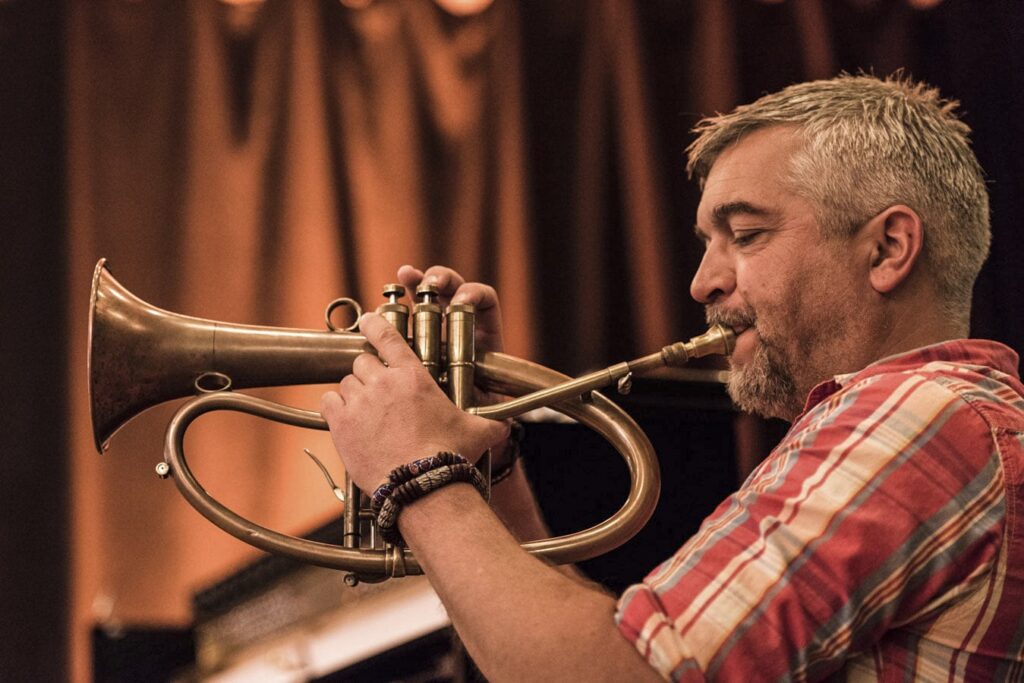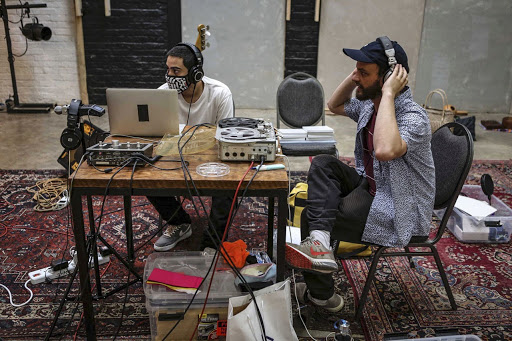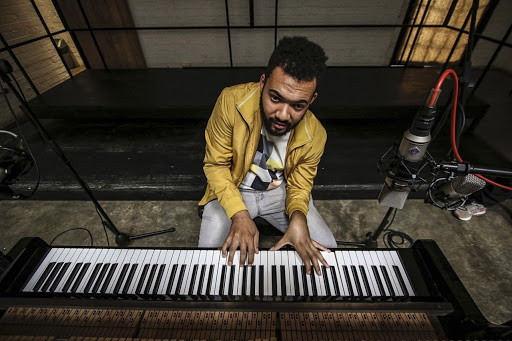Sakhile Moleshe, Ann Masina and Zoë Modiga during the recording of Tongues, part of a series of improvised collaborations recorded at the Centre for the Less Good Idea. (Photo: Zivanai Matangi/Centre for the Less Good Idea)
Live-streaming and collaboration have been the buzzwords of lockdown music. Despite no gigs, no gatherings and no venues, players with the skills and resources have still come together to make music for digital stages.
Something else is emerging from those joint ventures too. The apparently fixed categories of the legacy commercial music scene — roles, models, genres and more — were already feeling contingent pre-Covid, as new technology reversed old value chains. Now, some collaborations are simply dissolving them.
For trumpeter Marcus Wyatt and bassist Romy Brauteseth, what began as one duo session streamed from their shared Sophiatown home in April last year has turned into “In Concert @ House on the Hill”: almost a year of streamed performances in collaboration with South African small groups. Their work asks questions about performance aesthetics, band hierarchies and financial models.
For bassist Shane Cooper, the improvised Happenstance collaborations he recorded at the Centre for the Less Good Idea interrogate not only hierarchy and genre, but even what we call “music” and what we might dismiss as “sound”.
At House on the Hill, they film and record music and initiate archiveable artist conversations for, in Brauteseth’s words “a different documenting process that shows a more intimate side of the music and highlights each person’s character.” Next up is Tlale Makhene on March 11.
That the two know many of the artists so far featured helps (although they hope to extend the roster, particularly to less-publicised and older-generation players); so does their small, friendly home studio setting. “By the time we get artists onto our little yellow couch for the conversation,” Brauteseth says, “they’re relaxed enough to talk freely”.
 Marcus Wyatt has been experimenting with new ways to make music for digital stages. (Photo: Stéphane Olivier Vuille)
Marcus Wyatt has been experimenting with new ways to make music for digital stages. (Photo: Stéphane Olivier Vuille)
Wyatt feels the setting supports honest performance. Rather than encouraging people to “step in front of the audience and become somebody else,” this quiet, intimate setting “allows musicians not to be that ‘Version B’ — that’s what we’re going for.” The duo use the acoustics of the space and their engineering skills to support what Wyatt calls “light and shade and silence in the music”, rather than instrumental bombast or sound values better suited to “rock music played in a barn”.
Even though they use home resources, such ventures need support — and artists need to eat. Brauteseth and Wyatt made various approaches, and the first four concerts were funded by the Goethe Institute, which immediately appreciated the concept “with absolutely no strings, except their governance rules don’t permit monetisation”. A similarly supportive, hands-off donor they prefer not to name will carry the concerts forward.
Wyatt tried to evaluate various business models: “I looked for the numbers — but there are no relevant numbers! Ideally, of course, we shouldn’t give music away for free, but we’re still building a brand.” Musicians each receive an equal session fee, irrespective of being bandleader or member. Wyatt sees a future role for sponsor-supported, fixed, equitable fees too, in breaking the tyranny of the “door deal — because after Covid that’ll come back with a vengeance”.
 Romy Brauteseth, one of the co-conspirators of “In Concert @ House on the Hill” (Stéphane Olivier Vuille)
Romy Brauteseth, one of the co-conspirators of “In Concert @ House on the Hill” (Stéphane Olivier Vuille)
“As musicians,” says Brauteseth, “we definitely understand the value of earning. But having an online presence can support future bookings too. We consulted about whether posting free online was undercutting [other offerings], and the feeling was it’s more important to have performances accessible … and for it to be something artists are proud of.”Cooper was also fortunate to have no-strings support — from the Centre for the Less Good Idea — for four Happenstance collaborative sound projects, two of which are scheduled for a 26 April release on vinyl from UK-based Kit Records.
 Assistant recording engineer Zain Vally with bassist Shane Cooper at the recording desk, as they worked on the Happenstance collaboration. (Photo: Zivanai Matangi/Centre for the Less Good Idea)
Assistant recording engineer Zain Vally with bassist Shane Cooper at the recording desk, as they worked on the Happenstance collaboration. (Photo: Zivanai Matangi/Centre for the Less Good Idea)
Cooper had already created work at the 2020 Africa Synthesised online conference exploring the sonic possibilities (“the possibilities are born out of the limitations”) of collaging tape from an analogue, reel-to-reel recorder with input from only two microphones, a vintage device he’d inherited from his father.
Now, with lockdown lifted slightly, “I could invite collaborators into the same room. People could really listen to themselves acoustically, without the studio barriers of booths and headphones,” he says.
The result was three sessions — Static, Skins and Tongues — in which collaborators created spontaneous music in response to discussion and visual scores, plus a fourth, Ecotones, drawing on sounds from nature.
“That happenstance created the seedlings. Then I spent weeks afterwards alone, cutting up the tapes, experimenting, scrapping, creating loops, all from that generative starting point,” says Cooper. “I was looking for ways to make the musical transitions sound true.”
The centre is not designed for recording, so the first rigid envelope to go was studio sound. “It’s a big room with lots of reverb, not insulated: you can hear the traffic outside. I worked to incorporate those ‘sonic blemishes’ to become sonic textures,” Cooper says.
For each session, he collaborated with musicians he knew and some he didn’t, including classical cellist Daliwonga Tshangela. The elements from Tshangela’s sound and style in Static, he says, “speak towards one language for collaborations”.
 Bokani Dyer in Happenstance. (Photo: Zivanai Matangi/Centre for the Less Good Idea)
Bokani Dyer in Happenstance. (Photo: Zivanai Matangi/Centre for the Less Good Idea)
Cooper’s leadership role in Happenstance was also highly fluid. Although his deliberation shaped the final tapes, in the live collaboration, “I had to be equally willing to dive into the unknown and explore my curiosity — not just put my collaborators in the dark, tell them what to do and film them.”
The fourth session — Ecotones — challenges boundaries further. When invited to extend his planned three sound projects to a fourth, Cooper proposed work with artist-researcher Zayaan Khan “to see how far the centre was prepared to stretch the limits”.
Cooper’s interest is in “micro- and macro-universes of sound: focusing in and focusing out” and he found common ground with Khan’s exploration of bacteria, fermentation and their sounds — “gigantic universes in the microscopic realm.”
The Ecotones soundscape parallels the slowed clips of cricket and frog song he cut into Cara Stacey’s traditional instrumentation in Static.
Echoing the early pioneers of electronic music, like Cairo-born composer Halim el-Dabh, Cooper believes any sound from life can be musical within “a sequence of tension and resolution”.
It’s going to be tough, he knows, for Kit Records to place Happenstance in any drop-down marketing menu.
And that’s rather the point. Technologies of music production and distribution — cut-up tape, digital mixing, online streaming — in contexts of diverse collaboration, hold the potential to render everything liminal. Industry roles and genre categories are up for question. A platform can also be an archive. The scrape of a bassist’s fingers, or a cricket’s wings, can both be music. Everything, as Cooper describes it, is “dancing between sound-spaces”.